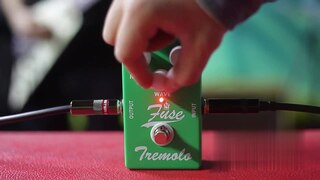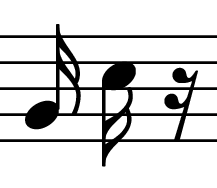
Music notation or musical notation is any system used to visually represent aurally perceived music played with instruments or sung by the human voice through the use of written, printed, or otherwise-produced symbols, including notation for durations of absence of sound such as rests.

In music, tremolo, or tremolando, is a trembling effect. There are two types of tremolo.

A quarter note (American) or crotchet (British) is a note played for one quarter of the duration of a whole note. Quarter notes are notated with a filled-in oval note head and a straight, flagless stem. The stem usually points upwards if it is below the middle line of the stave or downwards if it is on or above the middle line. However, the stem direction may differentiate more than one part. The head of the note also reverses its orientation in relation to the stem.

In music, a half note (American) or minim (British) is a note played for half the duration of a whole note and twice the duration of a quarter note. It was given its Latin name because it was the shortest of the five note values used in early medieval music notation. Half notes are notated with a hollow oval notehead like a whole note and straight note stem with no flags like a quarter note. The half rest denotes a silence of the same duration. Half rests are drawn as filled-in rectangles sitting on top of the middle line of the musical staff, although in polyphonic music the rest may need to be moved to a different line or even a ledger line. As with all notes with stems, half notes are drawn with stems to the right of the notehead facing up when they are below the middle line of the staff. When they are on or above the middle line, they are drawn with stems on the left of the notehead facing down.

A whole note (American) or semibreve (British) in musical notation is a single note equivalent to or lasting as long as two half-notes or four quarter-notes.

An eighth note (American) or a quaver (British) is a musical note played for one eighth the duration of a whole note (semibreve), hence the name. This amounts to twice the value of the sixteenth note (semiquaver). It is half the duration of a quarter note (crotchet), one quarter the duration of a half note (minim), one eighth the duration of whole note (semibreve), one sixteenth the duration of a double whole note (breve), and one thirty-second the duration of a longa. It is the equivalent of the fusa in mensural notation.

In music, a double whole note (American), breve, or double note is lasting two times as long as a whole note. It is the second-longest note value still in use in modern music notation.

In music notation, a tie is a curved line connecting the heads of two notes of the same pitch, indicating that they are to be played as a single note with a duration equal to the sum of the individual notes' values. A tie is similar in appearance to a slur; however, slurs join notes of different pitches which need to be played independently, but seamlessly (legato).
A tie is a curved line above or below two notes of the same pitch, which indicates that they are to be performed like one note equal in length to the two.

In music, a thirty-second note (American) or demisemiquaver (British) is a note played for 1⁄32 of the duration of a whole note. It lasts half as long as a sixteenth note and twice as long as a sixty-fourth.
In music notation, a sixty-fourth note (American), or hemidemisemiquaver or semidemisemiquaver (British), sometimes called a half-thirty-second note, is a note played for half the duration of a thirty-second note, hence the name. It first occurs in the late 17th century and, apart from rare occurrences of hundred twenty-eighth notes (semihemidemisemiquavers) and two hundred fifty-sixth notes (demisemihemidemisemiquavers), it is the shortest value found in musical notation.

In Western musical notation, a dotted note is a note with a small dot written after it. In modern practice, the first dot increases the duration of the basic note by half of its original value. This means that a dotted note is equivalent to writing the basic note tied to a note of half the value – for instance, a dotted half note is equivalent to a half note tied to a quarter note. Subsequent dots add progressively halved value, as shown in the example to the right. Though theoretically possible, a note with more than three dots is highly uncommon; only quadruple dots have been attested. If the original note is considered as being of length 1, then a quintuple dot would only be 1/32 longer than the quadruple dotted note. The difficulty may be seen by comparing dotted notation to tied notation: a quarter note is equivalent to 2 tied eighth notes, a dotted quarter = 3 tied eighth notes, double dotted = 7 tied sixteenth notes, triple dotted = 15 tied thirty-second notes, and quadruple dotted = 31 tied sixty-fourth notes. Although shorter notes do occur, sixty-fourth notes are considered the shortest practical duration found in musical notation.

In music, a hundred twenty-eighth note or semihemidemisemiquaver or quasihemidemisemiquaver is a note played for 1⁄128 of the duration of a whole note. It lasts half as long as a sixty-fourth note. It has a total of five flags or beams. Since human pitch perception begins at 20 Hz (1200/minute), then a 128th-note tremolo becomes a single pitch in perception at = 37.5 bpm.
A rest is a musical notation sign that indicates the absence of a sound.
The numbered musical notation, is a musical notation system widely used in music publications in China. It dates back to the system designed by Pierre Galin, known as Galin-Paris-Chevé system. It is comparable to the Gongche notation from the Tang Dynasty.

Alla breve[alla ˈbrɛːve] – also known as cut time or cut common time – is a musical meter notated by the time signature symbol , which is the equivalent of 2
2. The term is Italian for "on the breve", originally meaning that the beat was counted on the breve.

In music notation, a note value indicates the relative duration of a note, using the texture or shape of the notehead, the presence or absence of a stem, and the presence or absence of flags/beams/hooks/tails. Unmodified note values are fractional powers of two, for example one, one-half, one fourth, etc.

Mensural notation is the musical notation system used for European vocal polyphonic music from the later part of the 13th century until about 1600. The term "mensural" refers to the ability of this system to describe precisely measured rhythmic durations in terms of numerical proportions between note values. Its modern name is inspired by the terminology of medieval theorists, who used terms like musica mensurata or cantus mensurabilis to refer to the rhythmically defined polyphonic music of their age, as opposed to musica plana or musica choralis, i.e., Gregorian plainchant. Mensural notation was employed principally for compositions in the tradition of vocal polyphony, whereas plainchant retained its own, older system of neume notation throughout the period. Besides these, some purely instrumental music could be written in various forms of instrument-specific tablature notation.

In musical notation, a beam is a horizontal or diagonal line used to connect multiple consecutive notes to indicate rhythmic grouping. Only eighth notes (quavers) or shorter can be beamed. The number of beams is equal to the number of flags that would be present on an unbeamed note. Beaming refers to the conventions and use of beams. A primary beam connects a note group unbroken, while a secondary beam is interrupted or partially broken.

In music, a notehead is the part of a note, usually elliptical in shape, whose placement on the staff indicates the pitch, to which modifications are made that indicate duration. Noteheads may be the same shape but colored completely black or white, indicating the note value. In a whole note, the notehead, shaped differently than shorter notes, is the only component of the note. Shorter note values attach a stem to the notehead, and possibly beams or flags. The longer double whole note can be written with vertical lines surrounding it, two attached noteheads, or a rectangular notehead. An "x" shaped notehead may be used to indicate percussion, percussive effects, or speaking. A square, diamond, or box shaped notehead may be used to indicate a natural or artificial harmonic. A small notehead can be used to indicate a grace note.

In music, a two hundred fifty-sixth note is a note played for 1⁄256 of the duration of a whole note. It lasts half as long as a hundred twenty-eighth note and takes up one quarter of the length of a sixty-fourth note. In musical notation it has a total of six flags or beams. Since human pitch perception begins at 20 Hz (1200/minute), then a 256th-note tremolo becomes a single pitch in perception at quarter note ≈ 18.75 bpm.


![Comparison of duple note values ( = 2x, etc.)
.mw-parser-output .navbar{display:inline;font-size:88%;font-weight:normal}.mw-parser-output .navbar-collapse{float:left;text-align:left}.mw-parser-output .navbar-boxtext{word-spacing:0}.mw-parser-output .navbar ul{display:inline-block;white-space:nowrap;line-height:inherit}.mw-parser-output .navbar-brackets::before{margin-right:-0.125em;content:"[ "}.mw-parser-output .navbar-brackets::after{margin-left:-0.125em;content:" ]"}.mw-parser-output .navbar li{word-spacing:-0.125em}.mw-parser-output .navbar-mini abbr{font-variant:small-caps;border-bottom:none;text-decoration:none;cursor:inherit}.mw-parser-output .navbar-ct-full{font-size:114%;margin:0 7em}.mw-parser-output .navbar-ct-mini{font-size:114%;margin:0 4em}.mw-parser-output .infobox .navbar{font-size:100%}.mw-parser-output .navbox .navbar{display:block;font-size:100%}.mw-parser-output .navbox-title .navbar{float:left;text-align:left;margin-right:0.5em}
v
t
e Duple note values comparison.png](http://upload.wikimedia.org/wikipedia/commons/thumb/0/0c/Duple_note_values_comparison.png/220px-Duple_note_values_comparison.png)
 = 2×
= 2×  , etc.)
, etc.) 









